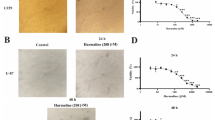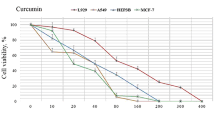Abstract
Curcumin, a yellow pigment in turmeric, is a food factor withantioxidative activity. The effect of curcumin on the proliferation and invasion of the rat ascites hepatoma AH109Acells was studied in vitro and ex vivo assay systems. Especially, a co-culture system of the hepatoma cellswith mesothelial cells derived from rat mesentery was employed to investigate the invasive motility. Curcumin suppressed thehepatoma slipping motility in a dose-dependent manner up to 5 μM and thereafter maintained the effect up to 20 μM, whereas this substance exerted little influence on the proliferation of the hepatoma cells at the same concentrations. Sera obtained from rats orally given curcumin also inhibited the AH109A cellular invasive movement when added to the culturemedium. Hepatoma cells previously cultured with hypoxanthineand xanthine oxidase showed a highly invasive activity. Curcumin and curcumin-loaded rat sera suppressed this reactive oxygen species-potentiated invasive capacity by simultaneously treating AH109A cells with hypoxanthine, xanthine oxidase and either of curcumin samples. These resultssuggest that the antioxidative property of curcumin may beinvolved in its anti-invasive action.
Similar content being viewed by others

References
Akedo H, Shinkai K, Mukai M, Mori Y, Tateishi R, Tanaka K, Yamamoto R and Morishita T (1986) Interaction of rat ascites hepatoma cells with cultured mesothelial cell layers: A model for tumor invasion. Cancer Res 46: 2416–2422.
Albini A, Iwamoto Y, Kleinman HK, Matrin G, Aaronson SA, Kozlowski JM and McEwan RN (1987) A rapid in vitro assay for quantitating the invasive potential of tumor cells. Cancer Res 47: 3239–3245.
Began G, Sudharshan E and Rao AGA (1998) Inhibition of lipoxygenase 1 by phosphatidylcholine micelle-bound curcumin. Lipids 33: 1223–1228.
Damtew B and Spagnuolo PJ (1997) Tumor cell-endothelial cell interactions: evidence for roles for lipoxygenase products of arachidonic acid in metastasis. Prostaglandins Leukotrienes Essent. Fatty Acids 56: 295–300.
Holder GM, Plummer JL and Ryan AJ (1978) The metabolism and excretion of curcumin (1,7-bis-(4-hydroxy-3-methoxyphenyl)-1,6-heptadiene-3,5-dione) in the rat. Xenobiotica 8: 761–768.
Huang M-T, Lysz T, Ferraro T, Abidi TF, Laskin JD and Conney AH (1991) Inhibitory effects of curcumin on in vitro lipoxygenase and cyclooxygenase activities in mouse epidermis. Cancer Res 51: 13–19.
Huang M-T, Newmark HL and Frenkel K (1997) Inhibitory effects of curcumin on tumorigenesis in mice. J Cell Biochem Suppl 27: 26–34.
Kawamori T, Lubet R, Steele VE, Kelloff GJ, Kaskey RB, Rao CV and Reddy BS (1999) Chemopreventive effect of curcumin, a naturally occurring anti-inflammatory agent, during the promotion/ progression stages of colon cancer. Cancer Res 59: 597–601.
Kim JM, Araki S, Kim DJ, Park CB, Takasuka N, Baba-Toriyama H, Ota T, Nir Z, Khachik F, Shimidzu N, Tanaka Y, Osawa T, Uraji T, Murakoshi M, Nishino H and Tsuda H (1998) Chemopreventive effects of carotenoids and curcumins on mouse colon carcinogenesis after 1,2-dimethylhydrazine initiation. Carcinogenesis 19: 81–85.
Kozuki Y, Miura Y and Yagasaki K (2000) Inhibitory effects of carotenoids on the invasion of rat ascites hepatoma cells in culture. Cancer Lett 151: 111–115.
Lin L-I, Ke Y-F, Ko Y-C and Lin J-K (1998) Curcumin inhibits SK-Hep-1 hepatocellular carcinoma cell invasion in vitro and suppresses matrix metalloproteinase-9 secretion. Oncology 55: 349–353.
Liotta L, Rao CN and Barsky SH (1983) Tumor invasion and the extracellular matrix. Lab Invest 49: 636–649.
Liu X-H, Connolly JM and Rose DP (1996) Eicosanoids as mediators of linoleic acid-stimulated invasion and type IV collagenase production by a metastatic human breast cancer cell line. Clin Exp Metastasis 14: 145–152.
Menon LG, Kuttan R and Kuttan G (1995) Inhibition of lung metastasis in mice induced by B16F10 melanoma cells by polyphenolic compounds. Cancer Lett 95: 221–225.
Miura Y, Shiomi H, Sakai F and Yagasaki K (1997a) Assay systems for screening food components that have anti-proliferative and anti-invasive activity to rat ascites hepatoma cells: In vitro and ex vivo effects of green tea extract. Cytotechnology 23: 127–132.
Miura Y, Furuse T and Yagasaki K (1997b) Inhibitory effect of serum from rats administered with coffee on the proliferation and invasion of rat ascites hepatoma cells. Cytotechnology 25: 221–225.
Noel A, Calle A, Emonard HP, Nusgens BV, Simar L, Foidart J, Lapiere CM and Foidart J-M (1991) Invasion of reconstituted basement membrane matrix is not correlated with the malignant metastatic cell phenotype. Cancer Res 51: 405–414.
Osawa T, Sugiyama Y, Inayoshi M and Kawakishi S (1995) Antioxidative activity of tetrahydrocurcuminoids. Biosci Biotechnol Biochem 59: 1609–1612.
Poste G, Doll J, Hart IR and Fidler IJ (1980) In vitro selection of murine B16 melanoma variants with enhanced tissue-invasive properties. Cancer Res 40: 1636–1644.
Reddy ACP and Lokesh BR (1994) Studies on the inhibitory effects of curcumin and eugenol on the formation of reactive oxygen species and the oxidation of ferrous iron. Mol Cell Biol 137: 1–8.
Reich R and Martin GR (1996) Identification of arachidonic acid pathways required for the invasive and metastatic activity of malignant tumor cells. Prostaglandins 51: 1–17.
Shinkai K, Mukai M and Akedo H (1986) Superoxide radical potentiates invasive capacity of rat ascites hepatoma cells in vitro. Cancer Lett 32: 7–13.
Sreejayan N and Rao MNA (1996) Free radical scavenging activity of curcuminoids. Arzneimittelforschung 46: 169–171.
Sugiyama Y, Kawakishi S and Osawa T (1996) Involvement of the β-diketone moiety in the antioxidative mechanism of tetrahydrocurcumin. Biochem Pharmac 52: 519–525.
Tanaka M, Kogawa K, Nishihori Y, Kuribayashi K, Nakamura K, Muramatsu H, Koike K, Sakamaki S and Niitsu Y (1997) Suppression of intracellular Cu-Zn SOD results in enhanced motility and metastasis of Meth A sarcoma cells. Int J Cancer 73: 187–192.
Welch DR, Lobl TJ, Seftor EA, Wack PJ, Aeed PA, Yohem KH, Seftor REB and Hendrix MJC (1989) Use of the membrane invasion culture system (MICS) as a screen for anti-invasive agent. Int J Cancer 43: 449–457.
Yagasaki K, Miura Y, Okauchi R and Furuse T (2000) Inhibitory effects of chlorogenic acid and its related compounds on the invasion of hepatoma cells in culture. Cytotechnology 33: 229–235.
Yagasaki K, Tanabe T, Ishihara K and Funabiki R (1992) Modulation of the proliferation of cultured hepatoma cells by urea cycle-related amino acids. In: Murakami H, Shirahata S and Tachibana H (eds.) Animal Cell Technology: Basic and Applied Aspects. Vol.4 (pp. 257–263) Kluwer Academic Publishers, Dordrecht/Boston/London.
Zhang GY, Miura Y and Yagasaki K (1999) Effects of green, oolong and black teas and related components on the proliferation and invasion of hepatoma cells in culture. Cytotechnology 31: 37–44.
Author information
Authors and Affiliations
Corresponding author
Rights and permissions
About this article
Cite this article
Kozuki, Y., Miura, Y. & Yagasaki, K. Inhibitory effect of curcumin on the invasion of rat ascites hepatoma cells in vitro and ex vivo. Cytotechnology 35, 57–63 (2001). https://doi.org/10.1023/A:1008167502110
Issue Date:
DOI: https://doi.org/10.1023/A:1008167502110



